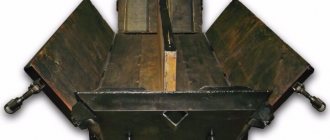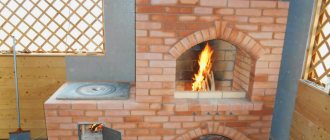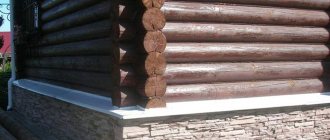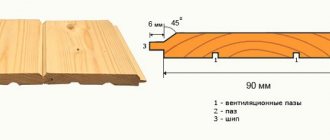How to properly dry a bathhouse after washing in winter
The floor in the steam room must remain completely dry, otherwise it will quickly darken and rot.
You can also dry the room using a large stove, preferably a brick one, which will quickly remove moisture from all bath rooms. After warming up, the brick will continue to release its heat into the air for a long time. It is recommended to provide through ventilation to make drying more efficient.
If the stove is not made of brick, then it is recommended to use the one located indoors. You need to throw firewood into the firebox and close all windows and doors tightly for a while. After the wood has burned, a draft should be created for final drying.
This method helps to quickly get rid of excess moisture and make the air dry.
After drying has been completed, you need to disinfect the air in the bathhouse by wiping the surfaces with water and dropping a little aromatic oil into it. This will get rid of mold and eliminate unnecessary odors.
In order for the sauna to serve for many years and maintain its beautiful appearance, it is recommended to dry it well each time after use. At the design and construction stage, an autonomous ventilation system should be provided that will ensure effective drying of all bath rooms. In addition, to quickly dry the bath, you need to make windows and doors on the south side.
What should not be used when ventilating in a steam room?
Avoid using plastic elements:
- corrugation;
- boxes;
- stubs
This is something that cannot be used for ventilation in a steam room - they cannot withstand high temperatures and will melt, releasing harmful substances and acquiring an unaesthetic appearance.
But their use in the wash room or dressing room is not prohibited.
Only wood can be used as plugs for vents or hatches: metal can burn from heat or rust when exposed to moisture.
Ventilate the bathhouse
A bathhouse needs regular ventilation - every self-respecting bath attendant knows this, but only a few follow this rule.
Why? The reasons are different - laziness, sacred belief in “maybe”, criminal shortsightedness. It is very difficult to combat rot that appears on damp logs. Therefore, it is better not to take things to extremes.
To make sure that all the wood is dry, after bathing procedures I wipe all surfaces with a rag. To create a draft, I open all windows and doors. Natural ventilation is an irreplaceable thing. One of my friends doesn’t like to wait, so he dries the bath in “express mode” using a fan. I do not support this method: as soon as the fan comes into contact with a wet surface, fun will be guaranteed.
In the winter months, ventilation has to be abandoned. Cold (and sometimes damp) air is not good for wood. Therefore, in winter and autumn, immediately after using the bathhouse, I close all doors and windows. Ventilation will also be required - but only the next day, when most of the moisture has gone.
Like Dislike 5_6 05 August 2012
Yesterday there was a bathhouse. 100 liters of water were poured over the entire period. When leaving, I turned on the TP to approximately 35 degrees,
In the south, the heat seems to be over 30 degrees - won't the draft dry it out?
I also had a bath on Saturday. When finished, I slightly opened the windows in the steam room and sink and the door between them. The stove is out, the SHIELD is hot. In the morning I came to the steam room - the temperature was 40 degrees. In the sink 35. Everything dry is already ringing. You can again warm up in the steam room in beach mode. It also happened in winter. Only in the steam room at -20 outside in the morning about + 20 degrees. Water does not freeze in temperatures down to -12 degrees from Saturday to Saturday. I used the bathhouse every Saturday all winter. Good luck
Lighting up the oven
Those lucky people who have a brick stove can take good care of their bathhouse. A heated brick accumulates heat and stores it for a long time after the room has cooled. Soft “residual” heating of the room together with cross-ventilation helps get rid of excess moisture without any tricks. I can’t boast of such a thing, so I make do with other drying methods.
My steam room has a standard Finnish stove.
It cools down quickly.
To achieve the brick oven effect, you need to put in extra effort. After entering the steam room, I throw firewood into the stove and open the ash pan. To keep the warm, dry air “concentrated,” I close the windows and doors. You can open them after the wood has completely burned out.
Folk remedies
Since stove heating has been used for centuries, there are many options for how to clean soot from a chimney using folk remedies. Many of them are quite effective, especially for prevention purposes.
Aspen firewood
The best way to clean soot from chimneys is aspen firewood, especially in the early stages of contamination. Despite the fact that aspen cannot be called a high-quality fuel, when burned it releases substances that help get rid of soot, so this product is quite effective. If you have a small supply of aspen firewood at home, then using it periodically will allow you to clean the chimney without making any effort.
Aspen firewood
Potato peeling
Another proven folk remedy is dried potato peelings. Cleaning a chimney from soot using this folk method is very simple, and such methods have been used for a very long time, and they have proven their effectiveness. Dried cleanings are simply poured into the firebox; when burned, they also release substances that peel off oxide deposits on the walls. It is also worth considering that after prevention with potato peelings, soot can fly out of the chimney for two to three days.
Folk method - burning potato peelings in an oven
Salt
If you are faced with the question of how to clean a metal chimney, then it is worth remembering such a common remedy as simple salt. You can even clean a stainless steel chimney with salt, as this is also one of the best and most affordable means. Salt is also simply poured into the firebox; when heated, sodium chloride reacts with carbon dioxide, as a result of which the soot simply flakes off. But it is worth remembering that pieces of soot can simply flake off and fall down, so the chimney mouth must be checked and cleaned periodically.
In addition, modern folk remedies have appeared on how to clean a chimney from soot, compiled by folk craftsmen, they are also effective, but in some cases they are unsafe, so we will not mention them. Do not carry out experiments, since if soot accumulates in a large amount in the chimney, it can simply ignite and, in the worst case, explode. Therefore, choose carefully how to clean the chimney so as not to damage the stove or the chimney itself.
Remember, a chimney that you periodically clean will be guaranteed to keep your home comfortable and safe.
How to dry a bath properly
In most cases, baths are decorated with wood. The material is loved due to its beauty and environmental friendliness. But, being constantly in a humid environment, it can become covered with mold or other fungi. This is why it is so important to dry bath areas after washing.
After water procedures, be sure to ventilate not only the steam room, but also all other rooms, including the washing room, dressing room, and rest areas, opening all windows and doors. Humid air gradually escapes into the street, so drying should take at least 3-6 hours.
Window for ventilating the steam room in the bathhouse
In winter, I do not recommend opening the door immediately after washing. Ventilate better the next day. Otherwise, frosty air can harm wood swollen from moisture and heat.
If there is no time for long-term ventilation, install a fan. This device will do an excellent job of drying walls and floors, and will cut the ventilation time in half.
Even if you postpone airing until the next day, be sure to wipe the walls and floor with non-woven material, trying to remove as much moisture as possible. Even a small puddle on the floor can cause mold to appear, which will grow, and you will have to treat the affected surfaces with special means - enhanced protection antiseptics.
Due to high dampness, black fungus may appear on the walls and floor of the bathhouse.
An important point - after using bath brooms, be sure to remove all remaining leaves from the walls and floor. The fact is that wet, steamed organic matter very quickly causes mold and wood rot. If the leaves get into the bath stones above the firebox, it’s okay, they will fade with further use.
Dry the bathhouse
Page 1 of 3
1 2 3 Next >
- Registration: 07/06/10 Messages: 149 Thanks: 5
registrar
Live here
Registration: 07/06/10 Messages: 149 Thanks: 5 Address: Moscow
In the summer they installed a bathhouse, a 6 x 4 log house with an outtake. Divided into two parts. In one part, which is larger, there is a relaxation room, in the other there is a steam room combined with a sink.
The stove is homemade. It heats up quickly, but in the rest room all the walls and ceiling are covered with condensation, despite the slightly open window.
Tell me how to dry it?
- Registration: 06.24.08 Messages: 231 Thanks: 69
Tuljak1
Live here
Registration: 06/24/08 Messages: 231 Thanks: 69 Address: Tula
Dry the bathhouse.
The stove is homemade, but which one: metal or brick? How is ventilation organized besides the window?
- Registration: 02/03/11 Messages: 490 Thanks: 459
Seal
Narrator
Registration: 02/03/11 Messages: 490 Thanks: 459 Address: Rybinsk
I'm afraid it will always be like this. With a combined steam room and sink going into the boiler room, the steam always condenses on the ceiling and walls! To alleviate this phenomenon, some people make a hatch in the ceiling and steam pours out there.
- Registration: 07/06/10 Messages: 149 Thanks: 5
registrar
Live here
Registration: 07/06/10 Messages: 149 Thanks: 5 Address: Moscow
The stove is metal, there is a brick pipe leading up to the ceiling, then there is double asbestos cement.
And if you make a small vestibule between the CO and the steam room, will it help?
Ventilation was hoped for through the window. There is a hole in the foundation between the floor and the concrete pour, I hoped that the inflow would be into this hole, and the outflow would be a window and a stove hood.
Hatch in the ceiling in a KO or steam room?
- Registration: 03/03/11 Messages: 12,443 Thanks: 12,442
ZYBY
MABI
Registration: 03.03.11 Messages: 12.443 Thanks: 12.442 Address: St. Petersburg, Bolshaya Vishera, Novgorod region.
I can assure you that if you make a vestibule at the ENTRANCE to the CO (from the street) and warm the CO, the process of steam generation in the CO will be significantly reduced. Although your combination will always float in KO.
- Registration: 07/06/10 Messages: 149 Thanks: 5
registrar
Live here
Registration: 07/06/10 Messages: 149 Thanks: 5 Address: Moscow
What if we make a small vestibule between the KO and the steam room?
- Registration: 03/03/11 Messages: 12,443 Thanks: 12,442
ZYBY
MABI
Registration: 03.03.11 Messages: 12.443 Thanks: 12.442 Address: St. Petersburg, Bolshaya Vishera, Novgorod region.
Let's decide what this vestibule will solve (between the steam room and the CO). If it is organized with a serious extraction of steam from the steam room, it will help. And if not, then the steam from the steam room, when entering a cool CO, will condense on the ceiling and walls.
Therefore you need:
1. Warm KO
2. Use natural wood to decorate the KO; everything else (plastic, chipboard, etc.) will collect drops.
- Registration: 12/07/09 Messages: 71 Thanks: 21
max50
Live here
Registration: 12/07/09 Messages: 71 Thanks: 21 Address: Pestovo village
This summer I built a 6*4 bathhouse. At first I planned, like you, to heat it from the KO, but after much thought I decided to turn the stove with the firebox into the dressing room. I have a similar layout, KO - 11 m2, a sink combined with a steam room and a dressing room - the same clean dimensions 1.75 * 3 each. I plan to heat from the dressing room. I plan to put a small heating stove in the KO, in case of a winter fishing trip. Unfortunately, now I don’t have the opportunity to post the layout plan, but I’ll do it these days. Today I was in the stove store, my head was spinning, my thoughts were scattered. I have not yet decided which stoves I will buy. And I would like the stoves to have a common chimney. Therefore, I will ask for advice from members of the forum.
- Registration: 07/06/10 Messages: 149 Thanks: 5
registrar
Live here
Registration: 07/06/10 Messages: 149 Thanks: 5 Address: Moscow
Why did you abandon the idea of firebox and CO? I have a firebox made of CO, and some of the heat still goes into the CO, which is very convenient (probably) in the off-season.
I made the stove to order, and lined it with bricks, leaving a gap between the bricks and the stove, so the steam room heats up quickly enough (on Saturday they heated it for the first time) and the bricks provide a heated mass, which allows you to throw one wood stove in the morning and go steam in half an hour later . It was minus 2 outside at night.
- Registration: 07/06/10 Messages: 149 Thanks: 5
registrar
Live here
Registration: 07/06/10 Messages: 149 Thanks: 5 Address: Moscow
We came to the conclusion that we really need to heat the boiler more, we will install an electric stove.
And yet I’m thinking of making a small vestibule 70cm x 70cm between the steam room and the CO. Make the walls of the vestibule out of plastic, then all the moisture will settle on the walls, flow down and make the floor at an angle into the steam room so that the condensation flows back.
Do you think it will help?
- Registration: 09/07/11 Messages: 12,410 Thanks: 17,234
pn2
steamy spirit
Registration: 09/07/11 Messages: 12,410 Thanks: 17,234 Address: St. Petersburg
If you keep this vestibule cold, then partly yes, but why cold condensate back into the steam room?
Well, due to the small volume of the vestibule, the effect is still insignificant.
- Registration: 05/31/11 Messages: 3,510 Thanks: 3,705
I'm building for myself
Drifter
Registration: 05/31/11 Messages: 3,510 Thanks: 3,705 Address: Chelyabinsk
made of good solid wood and good ventilation, and not just a draft from the hole below to the hole at the top, but think about how to take warm air from the rest room and throw it outside without creating drafts. Moreover, if there is effective ventilation, then it will clearly not be hot in this vestibule, and here your plastic will further reduce comfort. When drying the entire bathhouse after use, think about how this vestibule will dry, otherwise you risk getting a thick layer of frost on the walls of this vestibule by your next visit. If you warm it up, you will warm it up, but the humidity will already be enormous. Get additional uncontrolled ventilation in the steam room
- Registration: 07/06/10 Messages: 149 Thanks: 5
registrar
Live here
Registration: 07/06/10 Messages: 149 Thanks: 5 Address: Moscow
As long as it’s cool in the CO, the vestibule will also be cool. And when the CO heats up, condensation will not form so much.
As for the outflow of condensate, I agree that going back into the steam room is probably not advisable. But he is especially not needed in KO. Maybe make an outflow to the street?
- Registration: 06.24.08 Messages: 231 Thanks: 69
Tuljak1
Live here
Registration: 06/24/08 Messages: 231 Thanks: 69 Address: Tula
If you make an additional vestibule, you will get additional problems in terms of heating the rest room - it will take longer to heat up. Accordingly, the walls will be even colder than now and you will get even more condensation. I believe that you need to warm up the rest room properly before vaping. How is your ceiling insulated? I can tell you how organized it is for me. I’ll say right away that there was never any condensation. So: the metal stove is lined with half a brick and is dry. About 100 kg of stones. First, I heat the stove with the door open in the KO to a temperature of about 27 degrees in the KO. Then I close the door. At the same time, all my ventilation is open. Ventilation is organized simply: a pipe with a diameter of 100 mm is laid through all the walls under the ceiling opposite each other: this creates something of a draft. And in the steam room there is an additional pipe under the shelf leading outside. And after all the procedures, I throw three logs into the stove, open all the ventilation, open the door to the CO and go home. Everything dries out overnight. In your case, it may help to leave the window and the crack on the front door open. Good luck.
- Registration: 06/23/09 Messages: 3,406 Thanks: 5,261
NickB
Is it possible to dry a bathhouse using a stove?
If the steam room in the bathhouse is equipped with a brick stove, you can use it for drying. Brick and bath stones retain heat for a long time and dry the room on their own. But ventilation is still necessary; it can be done after drying.
If the stove is not brick, or has already cooled down, then after washing, throw some firewood into it and leave the ash vent open. A new portion of heat without water procedures will dry the surfaces. After the wood has completely burned out, open the window for ventilation.
How to properly dry a bathhouse after washing: quickly and easily + secrets of bathhouse attendants
We need a bathhouse not only to wash ourselves. It helps relieve stress, relax, gives vigor and strength. To maintain the longevity of the bath, you need to know how to properly dry it after washing. This is a mandatory rule so that the bathhouse pleases its owners for a long time.
Baths are often decorated with wood. It's environmentally friendly and beautiful. But, after washing, moisture accumulates on the wood, which leads to mold and mildew.
Flaxseed oil will help preserve the bath.
Treat the wooden floor in the bathhouse with linseed oil. Leave to dry for a day. After drying, you need to heat the bathhouse and remove excess oil with a rag. This will protect the wood from rotting, cracking, fungus and darkening.
If you leave the door open in winter after washing, cold air will begin to penetrate into the damp room and the floor in the bathhouse will quickly rot. In winter, after washing, close the windows and door. And the next day, open them for ventilation.
Question answer
What is burst ventilation?
This is when a significant amount of new air enters the room, but for a short time. Can be used between visits to the steam room or in the summer on an ongoing basis - for drying.
What additional steps should I take to speed up drying?
Collect excess water with a rag or sponge, remove wooden flooring and shelves and place them upright (it is better to make them removable from the beginning).
Do I need to close the doors during the final fire to dry out?
If there is good ventilation, be sure to close it. If not, then at first you need to keep the doors closed so that the heat does not escape, and then open them a few centimeters.
Should a forced exhaust fan be powered from a light switch?
Not worth it. It is better to display a separate toggle switch or key - there will be more freedom of action.
Drying the bath with a stove
If there is a brick stove in the bathhouse, then the brick will be hot for a long time and will warm up and dry the room on its own. But in addition you need to open the window.
If the stove is not made of brick, then after washing you need to throw a few logs into it and open the vent. After the wood burns out, open the window.
Experienced bath attendants
They claim that with any stove the room can dry quickly if you throw in a couple of logs after washing to let the stove work for another half hour. But you must remember to open the ventilation hole. Then proper drying occurs.
Ventilation in the steam room: device
It is based on the laws of physics: the influx of fresh air below displaces hot air from above through the corresponding openings, thereby ensuring air exchange. In this case, a vacuum of air occurs (the pressure decreases), and cool air is drawn in. It, in turn, gradually heats up, rushes upward, and further along the cycle. This is how ventilation works in a steam room; its design is quite simple. More about the ventilation system for baths here.
How to dry a bathhouse after washing to prevent it from rotting. Advice from an experienced bath attendant
Many people cannot imagine a proper vacation outside the city without a bathhouse. But constant heat and steam require careful care of the bathhouse in order to avoid large financial costs.
The main requirement for caring for a bathhouse is drying and washing it. If this requirement is ignored, excess moisture will lead to the formation of mold, mildew and other unpleasant consequences. Below are recommendations for bath care to avoid such consequences.
If mold does develop.
The above recommendations are designed to provide protection against mold and mildew. What to do in a situation where harmful microorganisms have already settled in the steam room? The modern market offers a wide range of special antiseptics that effectively deal with unwanted flora. The exception is fungus, which is very difficult to resist.
Especially dangerous. The so-called white house mushroom.
In the old days, the appearance of such a fungus in a house meant that the building was immediately burned down in order to prevent the fungus from spreading to neighboring houses. Today, such a mushroom is said to exist. But the casing damaged by such a fungus will in any case have to be dismantled and burned. The remaining surfaces must be treated with special protective compounds.
Advice from an old bath attendant: A radical measure is to treat the wood with machine oil. After such treatment, it will be impossible to use the bathhouse for some time due to the presence of an unpleasant odor until it is completely weathered, but this will keep the bathhouse intact and safe.
Source of the article: https://dom-srub-banya.ru/nuzhno-li-otkryvat-banyu-posle-pomyvki-zimoy/
Why steam your skin?
Skin steaming is used by professionals in their work - cosmetologists treat the face with steam, which opens the pores due to the gentle effect of heat. Steaming has always been a mandatory part of the manual cleaning protocol. And despite the emergence of cosmetic products that prepare the skin for this procedure, a vaporizer is still included in the basic toolkit of a cosmetologist, since steamed skin with open pores better accepts any care.
- Cleaning - manual or vacuum.
- Mask - moisturizing, anti-aging, cleansing, exfoliating. You can find out which mask is right for you by taking our test.
Ekaterina Turubara Medical expert Vichy
“Under the influence of high temperature, the pores open, which makes it easy to cleanse the skin with a scrub, mask or other cleanser. Steaming makes it easier to remove dead cells from the surface of the skin. Increasing the activity of the sweat glands helps eliminate accumulated toxins along with sweat. During this procedure, blood microcirculation also improves and the flow of oxygen to tissues accelerates. As a result, metabolic processes improve - the skin is rejuvenated, looks fresh and radiant.”
Contraindications
Exposure to hot steam should be avoided if you have weak capillaries and a tendency to rosacea. Remember that squeezing out inflamed comedones at home is prohibited even after steaming.
Steam is not contraindicated for dry skin. The main thing is to apply moisturizing treatment immediately after the procedure, without waiting for the condensation to completely evaporate.
Ventilation of the bath
Regular and proper ventilation of the bathhouse will help extend its service life for many years, and also prevent the appearance of dampness, rot and mustiness. After performing bath procedures, you need to wipe all surfaces (walls, benches, floors) from excess moisture with a dry rag. Be sure to open the windows and the front door - this will create a draft that will ensure effective ventilation.
A fan heater will help speed up the drying of the bath. When using this electrical appliance, you must follow generally accepted safety rules and do not place it on a wet surface.
In winter, the bathhouse is dried a little differently. Experienced bathhouse attendants do not recommend leaving the door open in the bathhouse in winter conditions after steaming and water treatments. Since cold air penetrating into a damp room only aggravates the situation with the destruction of wood - it begins to quickly rot. It would be more correct to close the door and windows after using the bathhouse. And only the next day ventilate the bathhouse.
It is worth remembering that a bath room is considered well dried when the floors are completely dry. After all, it is the floor in the bathhouse that is the most vulnerable and weak point. If not properly cared for, it will rot first.
Brief analysis of frequently encountered statements
Having opened two or three items at random in the top lines of the search results, a novice bathhouse owner is likely to encounter such statements.
I don’t dry anything (I don’t ventilate), and everything is fine
This statement can often be found as part of the answer to a newbie’s question about drying on third-party forums, and even in specialized bathhouses.
However, the laws of physics and biology, when combined together, are inexorable:
If a person really leaves everything after the steam room and leaves, then this may mean that:
Hence the conclusion: it is necessary to dry the bathhouse, and for this you need to know how to organize everything.
Just open the doors and that's it
What is attractive about this method is its simplicity. But here, too, not everything is clear. Opening the door to the steam room will actually improve air exchange. But in one bathhouse this can solve the drying issue, in another it will not be enough, and in a third it may be contraindicated to open the doors at all.
The drying method by opening the doors will be discussed in more detail below.
Use a fan heater
It would seem that the solution is incredibly simple: install an additional electrical appliance that will blow hot air into the steam room. As a precaution, it is indicated not to place the device on a wet floor (although to dry, excess moisture should be removed from the room with a rag or sponge).
In fact, a bathhouse that needs to be dried using a fan heater is the wrong bathhouse. In addition to the additional energy consumption (after all, it will take more than one hour to dry), there is an inconvenience with the power cord. Imagine that after using a robot vacuum cleaner you will have to additionally sweep away the dust with a broom into a dustpan - such an allegory suggests itself.
Drying the bath after the operating cycle should occur without the involvement of extraneous heat sources.
Rub with linseed oil
This advice wanders from one article to another.
In order to facilitate the drying process, it is recommended to thoroughly rub the wooden paneling, and especially horizontal surfaces - grates, shelves - with linseed oil. Oil will not help dry the steam room! However, impregnation has its advantages - the boards will be less susceptible to rot and mold, and will not dry out during the drying process.
Instead of linseed oil, some bathhouse owners recommend using lamp oil - it is inexpensive and has the highest degree of purification.
A sauna stove will speed up drying of the room
The sauna stove not only provides good steam, but also helps to quickly overcome humidity in the sauna room.
When the bathhouse is equipped with a brick stove, drying the room is quite quick and easy. The heated brick heats the air in the room for a long time, which promotes the evaporation of moisture. Additionally, you need to create cross-ventilation of the room using windows and doors.
If there is a stove in the bathhouse made of a different material, then it will have to be allowed to work a little more after the bathing procedures. To do this, you need to additionally throw a few firewood into the stove, open the ashpit, while simultaneously closing the windows and the front door. When the firewood has successfully burned out, you need to ventilate the room well, creating a draft.
Bath care with linseed oil
An excellent assistant in bath care is linseed oil. Treatment of wooden coverings with linseed oil is done after drying the entire room. The oil will help protect the wood not only from cracks and darkening, but also from rot and mold.
Rub the oil thoroughly on wooden floors and walls and leave to dry for 24 hours. Afterwards, the bath is heated and, if necessary, excess oil is carefully removed from wooden surfaces.
Source of the article: https://zen.yandex.ru/media/id/5ac15ebdbcf1bce1c578ad7d/kak-sushit-baniu-i-uhajivat-za-nei-chtoby-dolgo-slujila-hitrosti-opytnyh-banscikov-5ef0e1cace39fa7cca507f97











